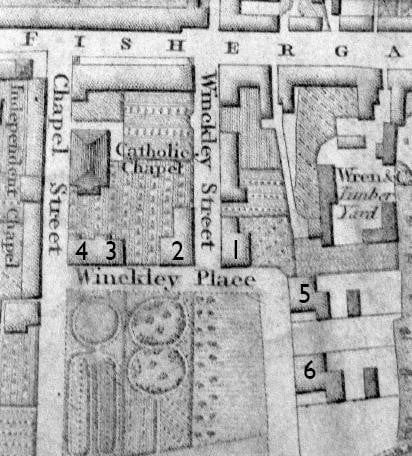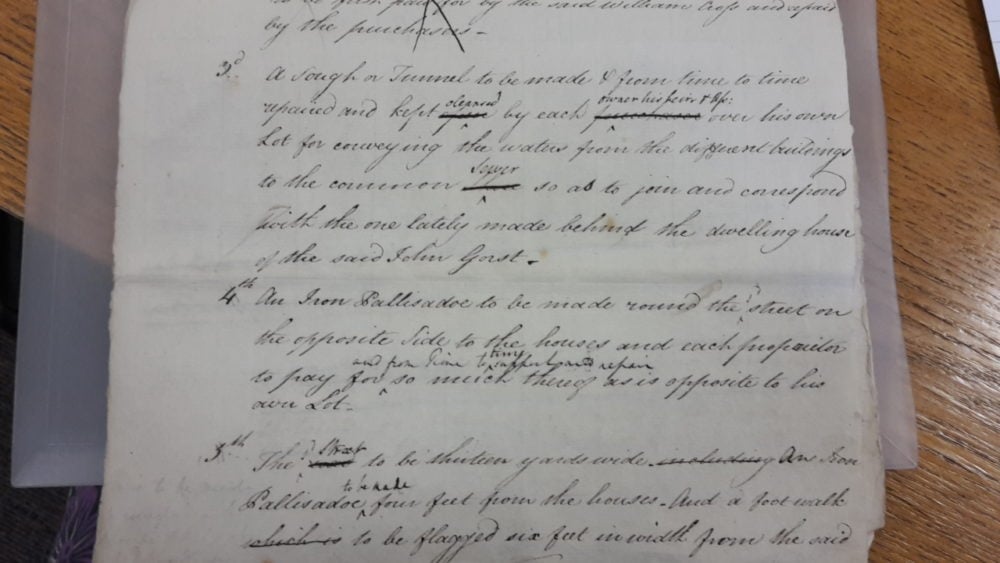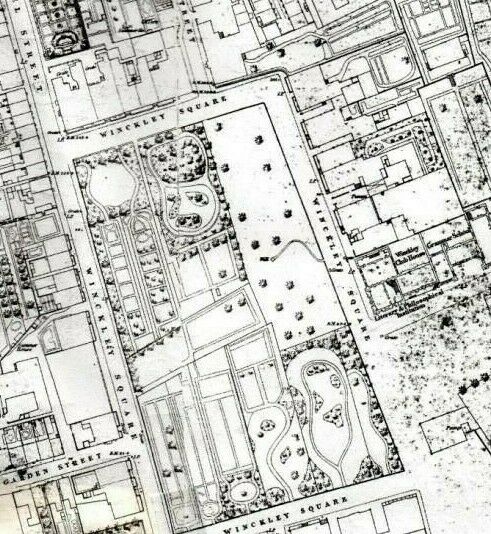
The Regulation of Winckley Square
William Cross built the first house overlooking the Square for himself in 1799 and then subsequently sold plots (called Lots) to his friends. Shakeshaft’s survey of 1809 shows the early development of Winckley Square. The numbers show the sequence of development.
In order to ensure the integrity of a Georgian Square William introduced stringent conditions that purchasers of plots had to agree to and comply with if they wished to build a residence on the Square. In the Lancashire Record Office, there is a “Draft Agreement on the Regulation of Winckley Square” (Ref. DDPd 11/60). It is dated 1807 and it clearly cites John Gorst and John Dalton’s houses as examples of what is expected:-

- William Cross
- Nicholas Grimshaw
- Joseph Seaton Aspden
- Edward Gorst
- John Gorst
- John Dalton
“Whereas the Sd several Persons Parties to these Presents are seized of or entitled to Houses or Lots for building Houses upon in a Square in Preston called or to be called Winckley Square… And whereas the Sd Wm Cross being greatly interested in promoting the building of good Houses and laying out the Sd oblong Piece of Land for the Convenience and Comfort of the Inhabitants of the Sd Square… hath agreed to permit the Sd Piece of Land to lie forever open and unbuilt upon… And the Sd other Parties to these Presents have agreed to join with the Sd Wm Cross his heirs and Afs in the Expense of laying out the Sd oblong piece of Land as Pleasure Ground and of forever hereafter keeping the same in neat order… The Houses in the Square to be built three Stories high and to be uniform in front as near as may be so as to correspond in general appearance with the houses built by the Sd John Gorst and John Dalton and not to be of less annual value than forty pounds.”
There were to be no ‘Factories Steam Engines disagreeable work or undertaking – nor any warehouses Necessary Houses Midden Steads – no Shop Tavern Inn or House of Public Entertainment.’
SANITARY FACILITIES
Poor people did not have lavatories with flushing water. Conditions in the back yards were appalling. The Cross Regulations were intended to require higher levels of sanitation from the owners of homes on the Square
- A ‘Necessary House’ was an outside lavatory
- A ‘Midden Stead’ referred to a pit dug next to an outside privy (lavatory) where household refuse (scrapings, off cuts) was thrown and the contents putrefied over time. Ashes from the fire were also tossed onto the midden stead. Ashes were used in the privy to cover the turds (Old English for Poo).
- Midden Steads were also known as Bog Holes
- The contents were carted away periodically. However, in Preston the work was carried out by a small team of paupers and elderly men for a population of over 50,000. Periodically could mean a very long time!
Bog Holes at the rear of properties on the Square are clearly marked on later 19th Century maps; suggesting the regulations were not always met.
Attention to detail made sure the householders were responsible for the building and continued repair of: the road in front of their home which had to be 13 yards wide, the iron balustrade surrounding their houses – 4 feet from the house, a 6 foot wide walk way, sewers from their home to the common sewer – similar to that built by John Gorst.

Some purchasers bought a piece of the central area which was to be laid out to gardens. William’s visions was this would be ‘laid out as Pleasure Ground’, and the residents were to have the keys of the general entrance gates. This 1824 illustration is based on an 1824 survey of Preston showing the gardens as a communal area. This did not materialise.
This reminds us that old maps are not necessarily reliable evidence for what was there. They can also be an image of what is planned or even wished for.

Ten of the residents owned plots and these were turned into individual gardens by 1849.

Also built into the regulations was the requirement for Proprietors to meet every 15th of April and 15th of November at Mr Cross’s office when a majority should have power to regulate the Planting, Lighting and Cleansing of the Square.
By Patricia Harrison